I’ll admit it …
I’m not the type of guy who loves cleaning guns.
In fact, I almost never do it.
I DO however keep my guns lubed because a good gun will run wet and dirty but if it’s not kept lubed, it probably won’t run.
The thing is, I’ve been shooting my little Glock 19 Gen 4 a good bit since I bought it last October and right now the best guesstimate of round count I have is approximately over 9,088 rounds (from my notes on range training sessions and class round counts … but I know I’m missing a few “fun” range days with friends that I did not account for).
Given that’s almost 10,000 rounds …
And this is my daily carry piece and I’ve done NOTHING in the way of cleaning or maintenance besides the aforementioned lubing often with the occasional field strip every 2,000 rounds (maybe) or so for a once over clean–I figured it was time to detail clean it.
By The Way, Your Handgun Has a Maintenance Schedule Too (Just Like Your Car) …
The truth is, I’ve put so many rounds through this gun now that I’m actually overduefor some routine part replacement maintenance.
Yes, guns, like cars and other mechanical machines actually have routine maintenance schedules for when the factory recommends you should replace their parts.
I’ll do another post on this separately, but suffice it to say that most gun guys never shoot their guns enough to know this or ever have to replace parts.
But I know some gun guys DO like to clean guns. I’m not one of them, but I’ll show you how I did it. So if you ARE that guy that’s super anal about cleaning his guns, feel free to flame me for telling me how I did it wrong 🙂
Before we start, MAKE SURE ALL GUNS ARE UNLOADED BEFORE CLEANING THEM.
Then check again to make sure it’s unloaded.
Then check AGAIN one more time. After you’ve checked the gun three times (seriously), then it’s time to clean it.
What My Glock With Almost 10,000 Rounds Looks Like
I have to admit, even I was pretty impressed with how dirty this little guy looked when I first field stripped it.
Good thing I decided to detail clean it!

A couple of things to note in this picture of the stripped Glock slide …
The safety plunger thing (the tiny little “barbell” looking piece) near the bottom of the picture was filthy. This is actually one of the internal Glock safeties that has to move before the striker will drop and fire the gun. Because of this, it’s a part of the trigger pull … so … I am guessing once this is cleaner it will improve the trigger pull.

You can also see the tons of black junk on the inside of the slide, etc.
But that’s not even the worse part, I’m cleaning the actual frame and trigger assembly of the gun too which has NEVER been cleaned as long as I’ve owned the gun.

You can see that practically EVERYTHING in the frame is covered with a nice layer of black (I guess it’s called carbon) and some pretty specks of what I’m guessing is a bunch of copper flakes.
Neat.
Then when I completely stripped the frame, you can see how bad the trigger assembly is covered in all that junk too …

I mean the trigger bar practically looks like it’s spray painted a matte black. And the locking block and slide stop lever aren’t too pretty either. Where the connector contacts the cruciform thingie though (forgot the real name) you can see the black junk is actually “oily” — due to making sure a drop of lube goes there each time I lube it (because it’s important to the trigger press).
In short, everything is filthy, so let’s clean it up!
The Difference Between a Detail Clean and a Field Strip
First off, most of us just “Field strip” a pistol when we need to clean it. And up until I decided to “detail clean” my Glock that was all I had ever done.

I snapped this pic while I was in the process of breaking down the Glock completely, because it’s basically a field strip. The next step would be to remove the barrel from the slide assembly, and that would be a field strip which usually consists of:
1. Take off slide
2. Take out barrel from slide
3. Take out recoil spring assembly from slide
4. Leave frame and trigger stuff alone
5. Clean and lube
If you’ve ever been taught to clean a gun, that’s basically how you’ve been taught.
But in this detail clean, I’m basically taking the whole Gun apart so that each and every individual piece can get clean.
Because I only had two hands and was doing the work, and because there are PLENTY of resources online on how to detail strip a Glock, I won’t show how it’s done.
If you are interested, here is a good video I found on Youtube for detail stripping:
Once I had detail stripped, it was time to clean it.
The Cleaning Supplies …

So what do we have here …
– Your pistol
– something to set it on so you don’t ruin the carpet (old tshirt)
– bunch of q-tips
– old toothbrush
– glock armorer tool for disassembly
– some rubber gloves (which I ended up forgetting to use)
– bore snake for cleaning barrel
– lube for reassembly
– two plastic containers
– Simple Green
I have heard of people doing this with just Dawn Degreaser Dish Soap. I have heard of them using Purple Power. I’ve heard of them using all kinds of cleaners.
I’ve also heard at least one person on the internet for each and every one of those cleaners say that you should NEVER use that cleaner on your gun …
Honestly, unless it’s something that will melt polymer, I don’t think it matters. All you’re looking for is a degreaser that you can add to water for this. And Simple Green is supposedly natural and a big ole jug of it like you see here was like $5 at Wal-Mart. Win-win.
Step 1: Detail Strip Your Pistol as Far as Possible
I took mine completely apart. Luckily, because I’m not a mechanical genius the Glock only has 34 component parts (if you took every spring off every little thing) in total and even fully stripped like this it was even more simple.
Step 2: Fill one container with simple green and water and drop the parts in.
I didn’t measure out a ratio, I just put “enough” in … then more later because I wanted more bubbles.

And here’s a picture when I finally got all the parts in there. See how simple this pistol is to break down?
And to think I was nervous!

Also notice that just dropping them in there and letting them soak a few minutes while I took this picture was enough for some of the junk to start falling off the trigger bar.
Step 3: Scrub all the parts clean.
You still gotta get in there with the toothbrush and scrub those parts though. I will say that I probably could of used a brass brush too for this part because I had NEVER cleaned this thing so there was some good built up carbon.

The Simple Green does do a good job of breaking it down and degreasing though.
Again, as you might imagine by this point, I’m not OCD about getting EVERY little part super clean, so I honestly didn’t let it soak or even scrub it as much as I should have … because I was basically doing all this in a hurry.

Also, use those q-tips to get in the hard to reach places. They’re perfect for the striker channel on the Glock for instance.
And if you have one of those “pick” things like most AR-15 cleaning kits come with you could use that to scrape any stuck on or hard to reach carbon too.
Scrub every little part down. Then it’s time to …
Step 4: Throw all the pieces you scrubbed and cleaned into the other container with pure water in it.

As you can see, I just kept them next to each other and threw the gun parts into the clean water bucket when I got tired of scrubbing them.
Then here’s a picture of all the parts just sitting in the tub of clean water.

Take a look at that trigger bar and how clean it looks now!
In fact, they’re all getting pretty clean already and this only took about 10-15 minutes (mostly because I was trying to think about taking pictures too).
Step 5: Pull them out and dry, then let dry.

I pulled them all out on the old tshirt and let most of the water drip out, then I manually grabbed another old tshirt and started drying them off.
If you have a nice work shop, you probably have an air compressor or something like that where you could air dry them super quick. Or you could do this outside with a nice breeze and plenty of warm sunlight to help.
Step 6: Admire your work and check for wear!
At this point, you can admire how clean everything Got. Honestly, I could not stop stairing at my trigger mechanism stuff:

I don’t know if the pictures even do it justice but it was a big difference as yo ucan see in this before and after picture:

At this point, when everything is clean, you should check for wear and tear and if it’s time for routine maintenance and part replacement, you should do it now.
Glock recommends checking:
1. External inspection
2. Barrel inspection
3. Firing pin safety check
4. Firing Pin
5. Firing pin channel
6. Extractor
7. Ejector
8. Slide Stop Lever Test
You can get more information on all these things from the Glock manual which either came with your gun or you can find online. Then you reassemble for testing/checking the rest.
Step 7: Put it all back together and function check.
The last thing you’ll want to do after cleaning your gun, whether you field strip it or detail strip it like this is to put the gun back together and function check it.
With the Glock, after reassembly, and while still UNLOADED, you cycle the slide and check to make sure the trigger can not be pulled from the sides (without engaging the trigger safety) to make sure the trigger safety works.
Then you test to make sure the trigger resets.
Finally, you stick an empty magazine in the gun and rack the slide and the slide should stay open.
Now You Have a Super Clean, Happy Gun!
Time to load that puppy up and take it to the range to get it dirty again …
I’m looking at this clean gun and starting to get itchy, it needs to get some bullets run through it ASAP 🙂
P.S. Here’s another video I found of a guy going through the whole process …







![Are Compensators Worth It? [Video]](https://preparedgunowners.com/wp-content/uploads/2025/07/Depositphotos_815431992_S-218x150.jpg)




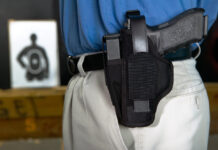
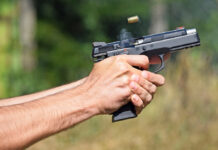
![Would-Be Robber Takes The Tueller Drill Challenge [Video]](https://preparedgunowners.com/wp-content/uploads/2025/10/Depositphotos_50626839_S-218x150.jpg)


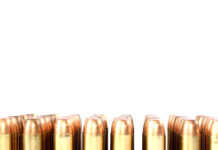
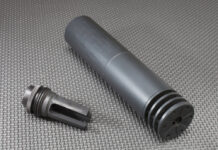
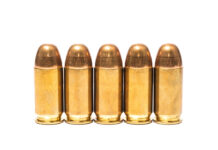











![Optic Ready vs Milled slides? [Video]](https://preparedgunowners.com/wp-content/uploads/2024/02/image-3-100x70.png)
![[Checklist] What Gear You Need To Take Pistol, Rifle & Shotgun Training Courses [Video]](https://preparedgunowners.com/wp-content/uploads/2023/07/Depositphotos_275087632_L-100x70.jpg)
![What is in Carter’s 2023 EDC? [Video]](https://preparedgunowners.com/wp-content/uploads/2023/07/Depositphotos_146856137_L-100x70.jpg)



I learned in the Army how best to clean a weapon and have been doing it this way since then. Lots of soap and scalding hot water. Rags and small brush, I use a tooth brush. If your water is really hot it will of course clean very well and the rinse water should be very hot as well. Then you let it air dry. The scalding hot water will dry on its own. Then you wipe down with a cloth. Lube you weapon and you are done. Really did a job on the M1 Garand.
that sounds logical
The only thing I would do different after drying all parts (I do use a compressor), I place all the parts onto a cookie sheet which I stole from my wife (now a permanent part of my gunsmithing bench). Then I spray all parts with Breakfree. Rub the Breakfree in with my fingers on all the parts except the polymer frame. Then I use paper towels to dry all the parts(a very little remains on the parts). I also use the Simple Green full strength and spray on all the parts in the same stolen cookie sheet. Your method of putting the Simple Greened parts in fresh water and sloshing them around is what I do, as Simple Green left on any metal part can be corrosive. I learned this method from a master gunsmith at the American Gunsmithing Institute. Thanks to them I now do most of my own gunsmithing. Something else I learned, it the vast majority of firearm malfunctions are due to dirty guns.
Great Marty!
Ok then, that’s where I heard the “Simple green” idea — someone mentioned the AGI gunsmith guy used it.
Good stuff!
That’s a great article, when Glock had first come to the United States. I was the first in the shooting group to actually purchase one. I loved it right out of the box, my friends made fun of me for buying a “toy gun”. It’s the original Gen 1, before they decided to change the slide spring to a single unit. I learned to do a total take down on it from a gunsmith. If you take care of it, it will take care of you. I have put well over 100,000 rounds through it. The only time I had a problem with it, was my mistake and I didn’t put powder in the case. The primer shot the slug about 3/4 of an inch in the barrel. I have replaced all the springs in it 3 times, and it’s probably about time to do it again. Other then that it’s about as tight as the day I bought it. I would have to get into the safe for the actual year purchased, but it was in early to mid 90’s.
Wow! 100,000 rounds that’s awesome!
Can’t wait till this one gets up there 🙂
Comments are closed.